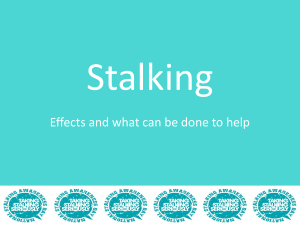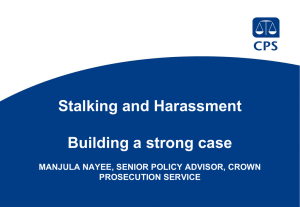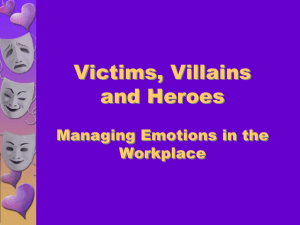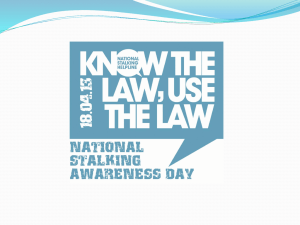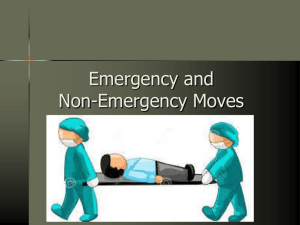Stalking the Stalker
advertisement
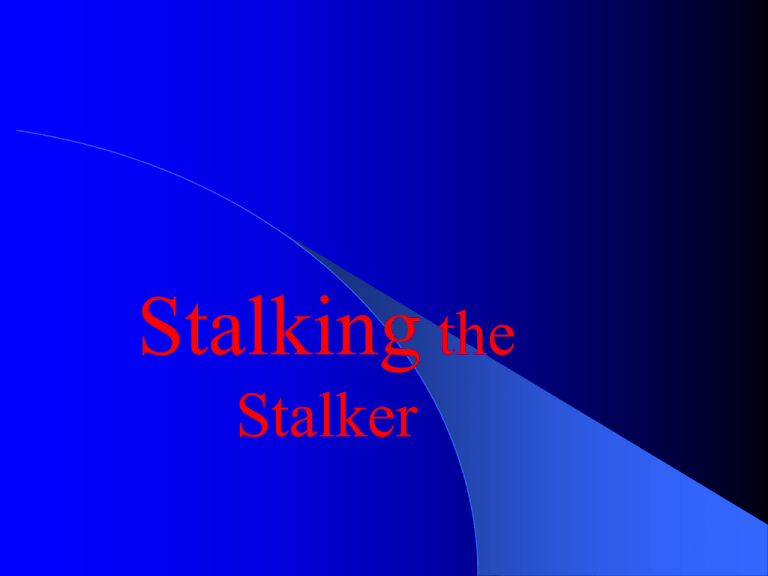
Stalking the Stalker Stalking Presentation May 2013 Bob Kaiser Asst. DA, Dane Co. RobertJ.Kaiser@da.wi.gov Mary Ricksecker Lt., Madison Police Dept. Retired “I wake up every morning, wondering if this is the day I will die at the hands of my stalker. I spend the day looking over my shoulder for him. I jump every time the phone rings. I can’t sleep at night from worrying. When I do sleep, I have nightmares of him. I can’t escape him for a minute. I never have a moment’s peace awake or asleep.” — A Stalking Victim Studies and Statistics National Violence Against Women Survey –1998 Tjaden &Thoennes Nation Sexual Victimization of College Women Survey –2000 Fisher,Cullen &Turner Femicide Study –1999 McFarlane et al What the studies tell us: There is a very big connection between DV & Stalking Also connection between stalking and Sexual Assault, especially clear in campus study Stalking is a huge risk factor for homicide Stalking affects millions of people What is Stalking? Any person who engages in a course of conduct directed at a specific person which places that person, or their family, in reasonable fear for their safety, commits the crime of stalking Stalking is a “course of conduct” Stalking behavior has to be viewed with the context of that “course of conduct” Each state defines stalking a little differently Stalking Behaviors Followed, spied on, stood outside home or work (82%) Made unwanted phone calls (61%) Sent unwanted letter, left unwanted item (33%) Vandalized property (30%) Killed or threatened to kill a pet (9%) (study conducted by the center for Policy Research) Stalker Demographic Profile Male (87%) White Between the ages of 18-35 Above average intelligence Personality or mental disorders Stalking Victim Demographic Profile Women (78%) Young (74%)--between the ages of 18-39 White (83%) Married (59%) Educated (35% high school 46% college) Relationship between the Stalker and the Victim Stranger 22% Acquaintance 18% Relative 4% Spouse/Partne r 42% Date 14% Simple Obsession Stalking Domestic Violence Stalking 60% of all stalking cases Among the most dangerous of cases: – 30% of all female homicides were committed by intimate partners – Domestic violence victims run a 75% higher risk of being murdered by their partner Michael Sveum (case study) SUSPECT: Michael W/M 26 yrs old when began stalking victim VICTIM: Jamie F/W 21 yrs old when stalking began RELATIONSHIP: ex-boyfriend/girlfriend had lived together off and on for 2yrs Daniel Kutz (case study) Daniel Kutz (2001) – – – – Convicted of 1st degree intentional homicide Stalking Hiding a corpse Resisting a officer Multi jurisdictional case – – – – Columbia Co. Sheriff Dane Co.Sheriff Deforest PD Madison PD Wisconsin Stalking Statute 940.32 (2) Whoever meets all of the following criteria is guilty of a Class I felony: (a) actor intentionally engages in a course of conduct directed at a specific person that would cause a reasonable person under the same circumstances to suffer serious emotional distress or to fear bodily injury to or the death of himself or herself or a member of his or her family or household. Stalking Law 940.32 (b) the actor knows or should know that at least one of the acts that constitute the course of conduct will cause the person to suffer serious emotional distress or place the specific person in reasonable fear of bodily injury to or the death of himself or herself or a member of his or her family or household. Stalking Law 940.32 (c) The actor’s acts cause the specific person to suffer serious emotional distress or induce fear in the specific person of bodily injury to or the death of himself or herself or a member of his or her family or household. NEW DEFINITIONS: (1)(a) “course of conduct means a series of 2 or more acts carried out over a period of time, however short or long, that show a continuity of purpose, including the following: Note: for dates after 7/30/02, that new statute applies, and after 4/27/04 this new statute applies, no matter how many acts were committed before. VENUE—2 or more acts means that so long as ONE is in your county, that’s enough to give your county jurisdiction. See 971.19(2), where a crime which requires 2 or mor acts to cmmit can be prosecuted in any county in which one of the acts occurred. Course of Conduct cont. COURSE OF CONDUCT: 1. Maintaining visual or physical proximity to the victim. 2. Approaching or confronting the victim. 3. Appearing at the victim’s workplace or contacting the victim’s employer or coworkers. 4. Appearing at the victim’s home or contacting the victim’s neighbors. Course of conduct cont. 5. Entering property owned, leased, or occupied by the victim. 6. Contacting the victim by telephone or causing the victim’s telephone or any other person’s telephone to ring repeatedly or continuously, regardless of whether a conversation ensues. COURSE OF CONDUCT, CONT’D: 6m. Photographing, videotaping, audiotaping, or, through any other electronic means, monitoring or recording the activities of the victim, regardless of where the act occurs; Course of Conduct cont. 7. Sending material by any means to the victim or, for the purpose of obtaining information about, disseminating information about, or communicating with the victim , to a member or the victim’s family or household or an employer, coworker, or friend of the victim. 8. Placing an object on or delivering an object to property owned, leased or occupied by the victim. Course of Conduct cont. 9. Delivering an object to a member of the victim’s family or household or an employer, coworker, or friend of the victim or placing an object on, or delivering an object to, property owned, leased, or occupied by such person with the intent that the object be delivered to the victim. 10. Causing a person to engage in any of the acts described in subsections 1 – 9. WHAT IF 1 – 9 IS ALSO ANOTHER CRIME? It is not required that the acts constituting the course of conduct be a crime in themselves for them to be charged as part of stalking; On the other hand, if the acts, such as battery (see enhancer 940.32(3)(a)), false imprisonment, DC, Recklessly endangering safety, violation of a RO or bail jumping are some of the acts constituting the course of conduct, they can and SHOULD be charged as additional crimes—they all have elements that are not required to be proved to prove stalking so they are not lesser included offenses. Definitions Suffer Severe emotional distress : means to feel terrified, initmidated, threatened, harassed, or tormented. Stalking Law 940.32 (2) Whoever meets all of the criteria (a), (b), (c), is guilty of a Class I felony. (THREE MAIN ELEMENTS) Stalking Law 940.32 (2e) Whoever meets all of the following criteria is guilty of a Class I felony: – (a) After having been convicted of sexual assault under s.940.225, 948.02, 948.025 or a domestic abuse offense, the actor engages in any of the acts listed sub.(1)(a) 1.to 10., if the act is directed at the victim of the sexual assault, or the domestic abuse offense. – (b) The actor intends that the act will place the specific person in reasonable fear of bodily injury to or the death of himself or a member of his family or household. Stalking Law cont. – (c) The actors act causes the specific induces fear in the specific person of bodily injury to or the death of himself or herself or a member of his or her family or household (1) (ap)”Domestic abuse offense” means an act of domestic abuse that constitutes a crime. (1) (am)”Domestic abuse” has the meaning given in s. 813.12(1) Stalking Law 940.32 (2m) Whoever violates sub (2) is guilty of a Class H felony if any of the following applies: – (a) the actor has a previous conviction for a violent crime, as defined in 939.632(1) (e) 1., or a previous conviction under this section or s. 947.013 (1r), (1t), (1v), or (1x). – (b) The actor has a previous conviction for a crime, the victim of that crime is the victim of the present violation of sub. (2), and the present violation occurs within 7 years after the prior conviction. Stalking Law cont (2m) cont. – (c) The actor intentionally gains access or causes another person to gain access to a record in electronic format that contains personally identifiable information regarding the victim in order to facilitate the violation. – (d) The person violates 968.31(1) or 968.34(1) in order to facilitate the violation. – (e) The victim is under the age of 18 years at the time of the violation. Stalking Law cont. (3) Whoever violates sub (2) is guilty of a Class F felony if any of the following applies: – (a) The act results in bodily harm to the victim or a member of the victims family or household. Stalking Law cont. (3) cont. – (b) The actor has a previous conviction for a violent crime, as defined in s. 939.632(1)(e)1., or a previous conviction under this section or s.947.013 (1r), (1t), (1v),or (1x), the victim of that crime is the victim of the present violation of sub. (2), and the present violation occurs within 7 years after the prior conviction. – (c). The actor uses a dangerous weapon in carrying out any of the act listed in sub(1)(a) 1.to 9. Stalking cont. 940.32 (4) (a) This section does not apply to conduct that is or acts that are protected by the person’s right to freedom of speech or to peaceably assemble with others under the state and U.S. constitutions, including, but not limited to, any of the following: – 1. Giving publicly to and obtaining or communicating information regarding any subject, whether by advertising, speaking or patrolling any public street or any place where any person or persons may lawfully be. Stalking cont. 940.32 (4) (a) 2. Assembling peaceably. – 3. Peaceful picketing or patrolling. (b) Paragraph (a) does not limit the activities that may be considered to serve a legitimate purpose under this section. (5) This section does not apply to conduct arising out of or in connection with a labor dispute. Stalking 940.32 (6) The provisions of this statute are severable. If any provision of this statute is invalid or if any application thereof is invalid, such invalidity shall not affect other provisions or applications which can be given effect without the invalid provision The Investigation Treat seriously—high lethality potential Educate Victim – What is stalking – Different kinds of threats – That pattern will not end with police investigation Get facts first, then approach fear issue. Victim may be less fearful than needs to be and more annoyed. – Can you guarantee safety? The Investigation Collect all notes, gifts, message tapes from victim Enlist victim in collecting evidence log, including how contact made victim feel and for how long – Screen calls – Answering machine tapes Have victim report all contacts The Investigation Interview Victim – Series of events so victim may need time to think and – – – – process Most recent, worst, what was the first behavior, etc. How did suspect meet victim How to locate suspect Prior relationships (other victims) No false promises to victims: – Can you guarantee safety? The Investigation If victim feels it is not safe to get TRO, explore reasons. Victim may be right. If suspect is at large, ask victim for a photo Discourage victim form any contact with the suspect. Any contact is good contact to the stalker The Investigation Interview victim about suspect’s…… – – – – – – Family members Best friends Hangouts Employment, past employers Vehicles, storage lockers, Post office boxes, email addresses, cell phone #’s, pagers, and any previous addresses – Financial information such as credit and banking cards for tracking purposes The Investigation Always do a search warrant – Look for evidence of obsession – Shrines in home or work – Evidence of criminal behavior – Journals or diaries of victim and/or other family members The Investigation If no violation, contact the stalker and advise of consequences Conduct surveillance if high risk lethality Apprehend for EVERY violation Visit each crime scene (photograph, measure, video, diagram) Make presentation to DA The Investigation Advise Judge of past activities and request high bonds Anticipate every case will be taken to trial by the stalker and prepare victim Questions for the Victim Has the suspect ever threatened you? Has the suspect ever attempted to assault or assaulted you? Has the suspect ever threatened or been physically violent with someone other than you ? Has the suspect committed any other violent act? Do you ever initiate contact with the suspect? For What reason? Preparing the victim for future incidents Seek support from people who understand. Avoid people who minimize the problem and tell you that you are overreacting. Do workouts with a buddy if you jog or go work out a club. (This will make the victim feel safer and will also provide a witness if the stalker approaches them. Don’t walk alone or jog at night. Ask security for escorts to car if necessary. Alternate secure or close parking arrangements if possible. If the victim is an employee, provide copy of RO to supervisor, provide picture. Emergency contact person if employer is unable to contact the employee. Safety in the workplace is big consideration. Victim Issues Experts suggest that where the offender is known the victim should send a clear written warning, CEASE-UNWANTED Under no circumstances should they continue to communicate with the stalker Victim should save all communications, record dates and times, emails etc. Victim may wish to file a complaint with their ISP and or Stalkers ISP (if cyberstalking) Other types of Interventions Letter to suspect w/ “no contact statement” from victim Letter from College Law enforcement contact Campus security contact Sample No Contact Statement (Spence-Diehl, 1999) [Stalker’s Name] I am not interested in having any type of a relationship with you. Do not continue to call me, send letters or have any other type of contact with me. Your behavior puts me in fear of my safety. If you continue, I will call the police and file stalking charges. [Victim’s Name] Victim Issues cont. Victim may wish to change ISP, look into privacy programs Victim should seek help/support from family/friends and law enforcement. Safety planning: before criminal charges are brought, at arraignment, pending trial, after trial or disposition. Creating a Safety Plan o o o Safety planning can be complex, it is helpful to enlist the assistance of a trained advocate and reach out to other campus resources Don’t underestimate the stalker’s potential for violence A victim who knows the stalker is the true expert on her safety Safety Plan Advice for Victims o o o o Do not attempt to communicate with the stalker If you are being followed, go to a safe, public area (police station)- don’t go home Get a new, unlisted phone number and use an answering machine Try to travel in a group or with friends Stalking’s Impact on Victims 83% of victims reported personality changes (Hall, 1998) 80% of victims reported increased anxiety and arousal due to the stalking; 75% had chronic sleep disturbances; and 33% met criteria for PTSD in DSM (Pathe & Mullen, 1997) 26% of female victims lost time from work, and 7% of female victims never returned to their jobs (Tjaden, 1998)
